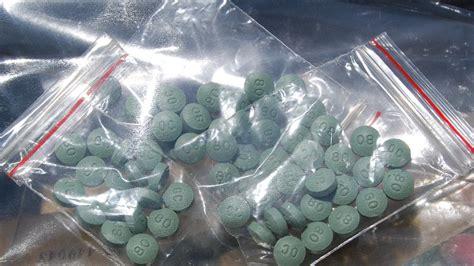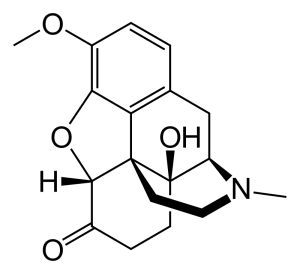
Oxycodone

The substance consists of eighteen carbon atoms, twenty-one hydrogen atoms, one nitrogen atom, and four oxygen atoms (C18H21NO4).
Nomenclature
Tilox, Oxi 80, OxyContin, Percotset, Oxicotton, Percodon, Roxicodon, Roxitset. Name according to IUPAC: (5R,9R,13S,14S)-14-гидрокси-3-метокси-17-метил-4,5-epoxymorphinan-6-он.
Form of production
Intramuscular injections, medication in the form of capsules, tablets, solution for intravenous manipulation.
History of the substance
The first mention of oxycodone appeared in early 1916, immediately after its synthesis in a university laboratory in Germany. The main substance from which it was produced was thebaine.
For medical purposes, C18H21NO4 began to be used 12 months after its development, in 1917. Oxycodone appeared on the American pharmaceutical market in the spring of 1939. The early 1960s were the impetus for the development of pharmaceutical science in the United States. As a result, a few months later, the highest authorities of America decided to include this substance in Schedule II of narcotic drugs.
The year 1995 was marked by the period of mass production of the brand “OxyContin”, which is still legally used in medicine.

Medical Uses
Oxycodone refers to narcotic analgesics of the opioid agonist group. The maximum threshold of effectiveness is achieved due to the impact on the body of a high dose of the main component. In addition to analgesic, the substance is used as a sedative, sleeping pills, as an analogue of the drug “codeine” for coughs. Oxycodone is often in medical practice prescribed in combination with paracetamol and aspirin.
The substance is recommended for cancer patients, as well as people who suffer from chronic pain. Prolonged use of the drug can cause drug addiction, so C18H21NO4 is dispensed strictly by prescription. Any illegal distribution of the drug in Germany is punishable under the Drug Law.
Signs of use
Determining that a person is under the influence of a narcotic substance is not easy, but there are a number of behavioral, physiological, obvious signs that confirm this fact. If a patient exhibits more than five symptoms from one or different groups, it is safe to state drug addiction.
Among the physiological signs should be alarming:
Pallor or discoloration of the skin;
redness of the eyes;
impaired coordination of movements;
Speech problems (slowness, sluggishness, incoherence);
constriction, dilation of the pupils;
appetite problems;
arrhythmia.

The most common behavioral symptoms are:
Unreasonable lethargy;
increased agitation;
loss of perception of what’s going on around them;
inattention, absent-mindedness;
estrangement, isolation from relatives;
Inability to concentrate on a particular situation;
problems with sleep;
frequent mood swings, negative reaction to comments;
conflicts in communication;
gambling;
theft of money or valuables from the house;
withdrawal, foul language, secrecy with friends, talking on the phone;
refusal to work, favorite activity, leisure activities;
false answers to questions asked, lying, making up tall tales;
tired appearance, unkemptness.
Obvious signs that confirm addiction include:
Lividity of the body, wounds in the form of bruises, cuts on the hands, in the area of the veins;
money rolled up in a tube, sheets of newspaper, paper;
smoked foil;
solutions, tin cans, syringes, pills, powders, flasks;
sedatives, sleeping pills, narcotic drugs;
self-made cigarettes in real cigarette boxes.
In the presence of one or more symptoms, the diagnosis of “drug dependence” on oxycodone is excluded, because such signs can be characteristic of a number of neuralgic, mental, chronic diseases, as well as transitional age.
Influence on the body
Once in the body, the drug oxycodone actively interacts with opioid receptors in the brain and spinal cord, causing a physiological response accompanied by pain, euphoria.
Abuse of this drug is fraught with persistent physiological and psychological dependence similar in its symptoms and mechanism of action to that of codeine. Physical addiction develops due to irritation of certain receptors by the substance. If there is no such influence on the background of euphoria, unexplainable processes reminiscent of “withdrawal” occur in the body. So he demands to get the next dose of the drug.
Oxycodone is contraindicated for pregnant women, because the drug penetrates into the blood and poisons the milk and placenta.
IMPORTANT: uncontrolled use of the drug, as well as its combination with barbiturates, antihistamines, alcohol are dangerous for the addicted person by suppression of respiratory function.
Due to the instant habituation, any form of the drug is forbidden to use as an element of substitution therapy, despite its effective suppression of withdrawal symptoms. Even minor deviations from the doctor’s prescribed dose are hard drugs. In the United States alone, Percodone and its forms have been fatal to more than 100,000 people.
The development of addiction
The following signs indicate that a person is abusing oxycodone:
Abrupt weight loss while eating normally.
Narrow pupils (no reaction to light).
Excessive hair loss, presence of baldness.
Thinning, roughness, pallor, and jaundice of the skin.
Blood pressure spikes.
Rapid deterioration of teeth.
Disturbance of heart rhythm.
The most pronounced indicators of addiction to the drug are psychiatric disorders, breakdown, rapid addiction, and panic attacks. Conditions of mental instability, schizophrenia, respiratory failure, depression of reproductive function are considered extremely dangerous.
Fatal consequences of use
Like any narcotic drug Oxycodone adversely affects all organs. Continuous use of the drug is fraught with rapid addiction, prompting each time to increase the dose, and cancellation of the drug entails severe agony.
Fatal consequences of use
Like any narcotic drug, Oxycodone adversely affects all organs. Continuous use of the drug is fraught with rapid addiction, prompting each time to increase the dose, and cancellation of the drug entails severe agony.
Uncontrolled use of C18H21NO4 provokes in an addict:
altered perception;
impaired respiratory function;
spasm of bronchial muscles, smooth muscles;
weakening of the expectorant reflex;
dehydration;
mood changes (anxiety, depression, euphoria);
sleep disorders;
nervousness;
confusion, memory lapses;
headaches;
tremors, involuntary muscle contractions;
epileptic seizures;
decreased blood pressure;
intestinal obstruction;
nausea, vomiting;
gastrointestinal disorders (tarry stools, diarrhea, gingivitis, hiccups);
skin rashes;
itching, dry skin;
herpes simplex;
frequent urge to urinate;
decreased libido, impotence.
Help in case of overdose
Oxycodone toxic intoxication occurs at a concentration of 0.6-10 mg/ml. Overdose is characterized by respiratory depression, forgetfulness, fainting, disorientation in space, bluish skin, hives rash, nausea, constriction of the pupils.
Severe cases are accompanied by arrhythmia and coma in addition to the main symptoms. Ingestion of too high concentrations of the drug substance may lead to fatal consequences – spontaneous acute heart failure and death.
If a person shows signs of an overdose, the following steps should be taken immediately:
call an ambulance;
prevent the patient from falling asleep;
create conditions of maximum air supply;
if there are no signs of life (cardiac arrest, no breathing) provide resuscitation measures before the arrival of the ambulance.
Recently, drug addiction to a number of drugs, including painkillers, has been a widespread problem throughout the world, so at the slightest suspicion that someone you know or a relative has this addiction, make every effort to get the person to a medical facility as quickly as possible and get qualified help.
